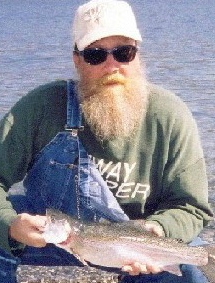Trolling a Fly with your Spinning Rod and Reel
(dans NOM RÉFÉRENCE – année référence)
par : Uncle Wes
As the season progress’s it seems that those trout become very wary of everything you have in your arsenal. You’ve tried all your hardware tactics and every piece of equipment in your tackle box, from flashers to worm trolls but nothing seems to be working. Don’t get stuck in that mind set that the fish aren’t biting or that the lake is fished out. Try something new, trolling a fly. But you say you can’t afford a fly rod and reel, not to mention the sinking fly line, backing and etc. Well don’t worry if you have a spinning rod and reel then you have the most versatile piece of equipment available at your disposal. This combination allows you to bank fish from the bottom, attach a bobber, and even troll your hardware. Remember it’s not the guys with the most toys or most expensive equipment that catch fish. It’s your knowledge, skill, and your flexibility that will produce fish consistently.
This is why I think we should talk a little bit about dragging a fly with your spinning rod. Here in the North West where I live the most productive trolling flies seem to be the Black Wooley Bugger, the Green Wooley Bugger, and the Green Carey Special. I have also heard that a purple leech pattern does very well. Talk to the folks in your area and I’m sure they will be glad to tell you, which fly works best for trolling your lake. Now lets talk about the set up, it’s very basic and simple. I start out with a snap swivel form my main line I prefer the black ones myself. I then attach a keel sinker, which is available in most tackle stores. They come in 1/16 oz all the way up to 4 oz. In my tackle box I carry 1/16, 1/8, ¼ and 3/8, sizes. The advantage to the keel sinker is that it doesn’t spin and twist your line and also runs truer than any other I’ve used. Next step is to attach you’re your fly and leader to the sinker. I prefer to use about 10’ of either 4lb or 6lb test leader. I then use a clinch knot to attach my fly to my leader, now your ready.
Now lets discuss tactics. I will talk about what works best for me and I’m sure there are other opinions and methods. Experiment until you find what’s working in a particular lake and most important what works for you. Now personally I prefer to troll a fly in the morning or evening hours. These times have been the most consistent for me. How I adjust my weight is by watching the water, if they are rising I will use very little weight. If not I will adjust my weight until I find the correct depth. When trolling I like to let out about a 100’ of line, it seems to get my fly far enough from the boat and the disturbance it causes as you go by. I use the standard S trolling pattern, not a real tight S but a long slow looping S, and every once in a while I will give a my rod a quick short twitching motion. I can tell you I have gotten some of the most violent strikes I’ve ever received using this method. I have noticed that the most productive areas for me in the early morning and late evening have been closer to shore in 4 to 6 feet of water, even closer if you dare. So if nothing seems to be working for you give this a try, it just might turn out to be another weapon in your arsenal.
